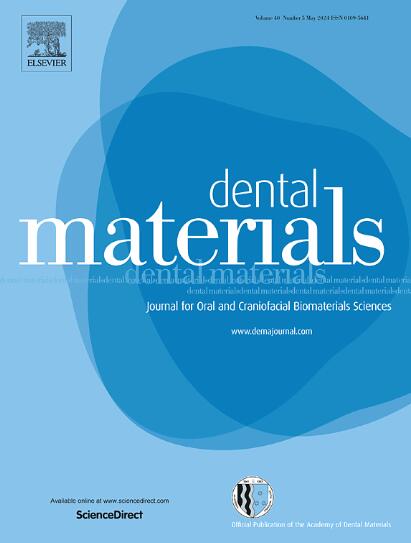优化不同配方的磷酸蚀刻时间:4年后对牙本质结构、粗糙度和粘合性能的影响。
IF 6.3
1区 医学
Q1 DENTISTRY, ORAL SURGERY & MEDICINE
引用次数: 0
摘要
目的:评价商业磷酸蚀刻时间对牙本质脱矿模式、牙本质粗糙度、化学定位、纳米渗漏(NL)和树脂-牙本质微拉伸结合强度(μTBS)的影响。方法:对四种商用磷酸进行了测试:Ultra-etch [ULE, 35 %],Scotchbond Universal Etchant [SUE, 32 %];Dentsply牙齿调理剂[DDC, 37% %]和Total Etch [TTE, 37% %]。188颗磨牙咬合牙本质分别蚀刻3和15 秒。通过扫描电镜观察脱矿模式,使用光学轮廓测量粗糙度,并通过微拉曼光谱获得化学作图。制备树脂-牙本质结合梁,在基线和水储存4年后进行NL和µTBS测试。资料采用三因素方差分析和Tukey检验(α = 0.05)进行统计学分析。结果:15秒刻蚀后,ULE的脱矿效果明显低于DDC和TTE,而SUE的脱矿效果为中间效果(p = 0.001)。蚀刻3 s后各组间无差异(p > 0.05)。ULE和SUE的管状密度低于DDC和TTE (p = 0.001)。粗糙度和化学图谱显示,所有组在3 秒时脱矿较低(p 0.05)。与腐蚀次数和老化时间无关,ULE和SUE的NL和μTBS值更高(p )。意义:即使在4年后,3秒的磷酸腐蚀时间也能对牙本质底物进行足够的修饰,使粘接剂渗透,保持粘接强度,减少纳米泄漏。酸的配方对脱矿模式和粘接性能有显著影响。本文章由计算机程序翻译,如有差异,请以英文原文为准。
Optimizing phosphoric acid etching times across different formulations: Impact on dentin structure, roughness, and adhesive performance after 4 years
Objective
To evaluate the effect of etching times with commercial phosphoric acids on the demineralization pattern, dentin roughness, chemical mapping, nanoleakage (NL), and resin-dentin microtensile bond strength (μTBS) when used with an etch-and-rinse adhesive, assessed immediately and after 4 years of water storage.
Methods
Four commercial phosphoric acids were tested: Ultra-etch [ULE, 35 %], Scotchbond Universal Etchant [SUE, 32 %]; Dentsply Dental Conditioner [DDC, 37 %] and Total Etch [TTE, 37 %]. Occlusal dentin from 188 molars was etched for 3 and 15 seconds. Demineralization patterns were observed via SEM, roughness was measured using optical profilometry, and chemical mapping was obtained through micro-Raman spectroscopy. Resin-dentin bonded beams were prepared for NL and µTBS testing at baseline and after 4 years of water storage. Data were statistically evaluated with three-way ANOVA and Tukey’s test (α = 0.05).
Results
After 15-second etching, ULE exhibited significantly less demineralization compared to DDC and TTE, while SUE had an intermediate effect (p = 0.001). No differences were observed among groups after 3-second etching (p > 0.05). ULE and SUE showed lower tubular density than DDC and TTE (p = 0.001). Roughness and chemical mapping indicated lower demineralization at 3 seconds for all groups (p < 0.002), except ULE, which showed similar at both 3 and 15 seconds (p > 0.05). NL and μTBS values were higher for ULE and SUE, regardless of etching times and aging period (p < 0.05). ULE demonstrated the best control over demineralization, followed by SUE, both enhancing resin-dentin bonding performance.
Significance
A 3-second phosphoric acid etching time produces sufficient dentin substrate modification for adhesive infiltration, maintaining bond strength and reducing nanoleakage—even after 4 years. The formulation of the acid significantly influences the demineralization pattern and adhesive performance.
求助全文
通过发布文献求助,成功后即可免费获取论文全文。
去求助
来源期刊

Dental Materials
工程技术-材料科学:生物材料
CiteScore
9.80
自引率
10.00%
发文量
290
审稿时长
67 days
期刊介绍:
Dental Materials publishes original research, review articles, and short communications.
Academy of Dental Materials members click here to register for free access to Dental Materials online.
The principal aim of Dental Materials is to promote rapid communication of scientific information between academia, industry, and the dental practitioner. Original Manuscripts on clinical and laboratory research of basic and applied character which focus on the properties or performance of dental materials or the reaction of host tissues to materials are given priority publication. Other acceptable topics include application technology in clinical dentistry and dental laboratory technology.
Comprehensive reviews and editorial commentaries on pertinent subjects will be considered.
 求助内容:
求助内容: 应助结果提醒方式:
应助结果提醒方式:


